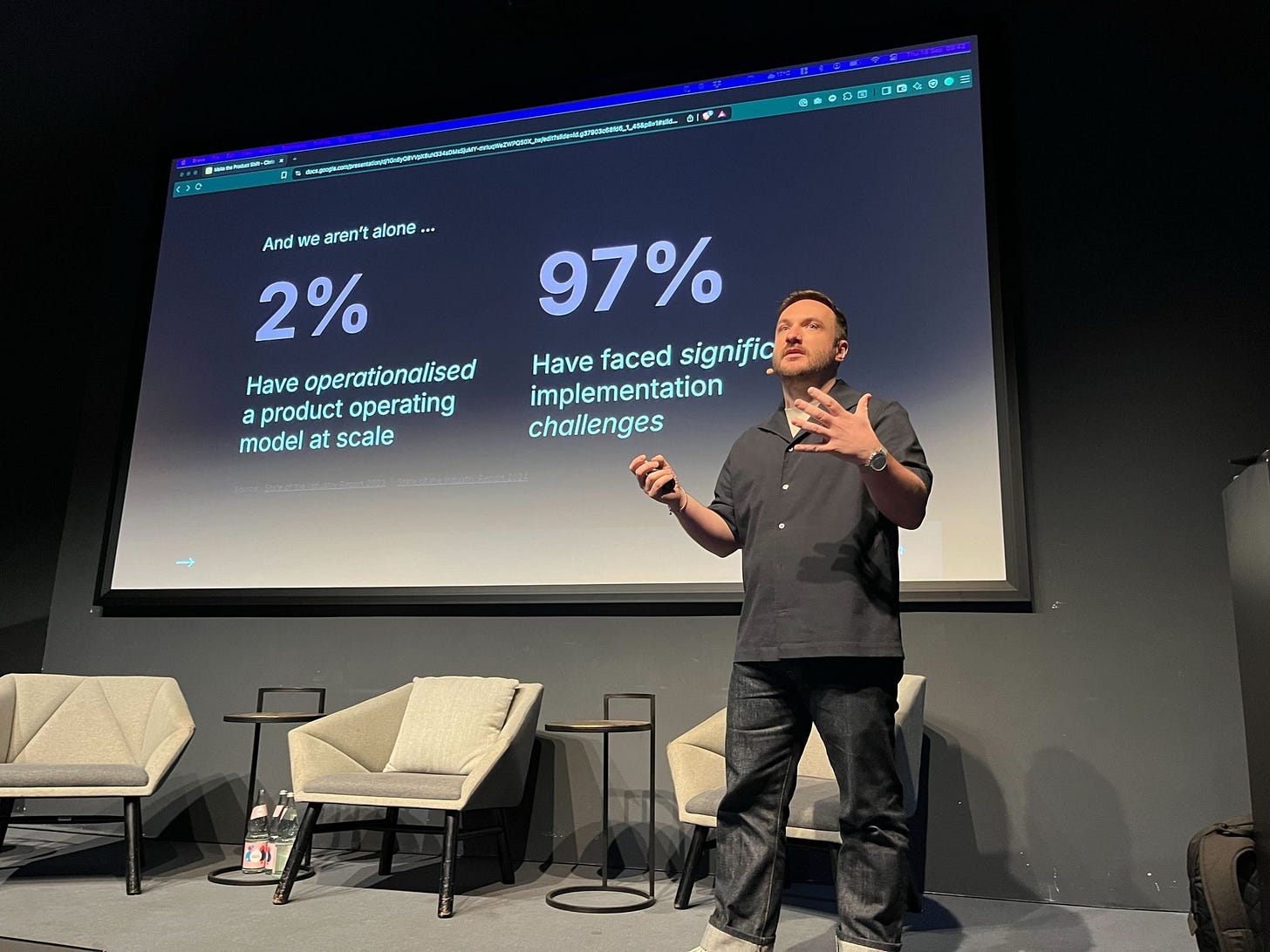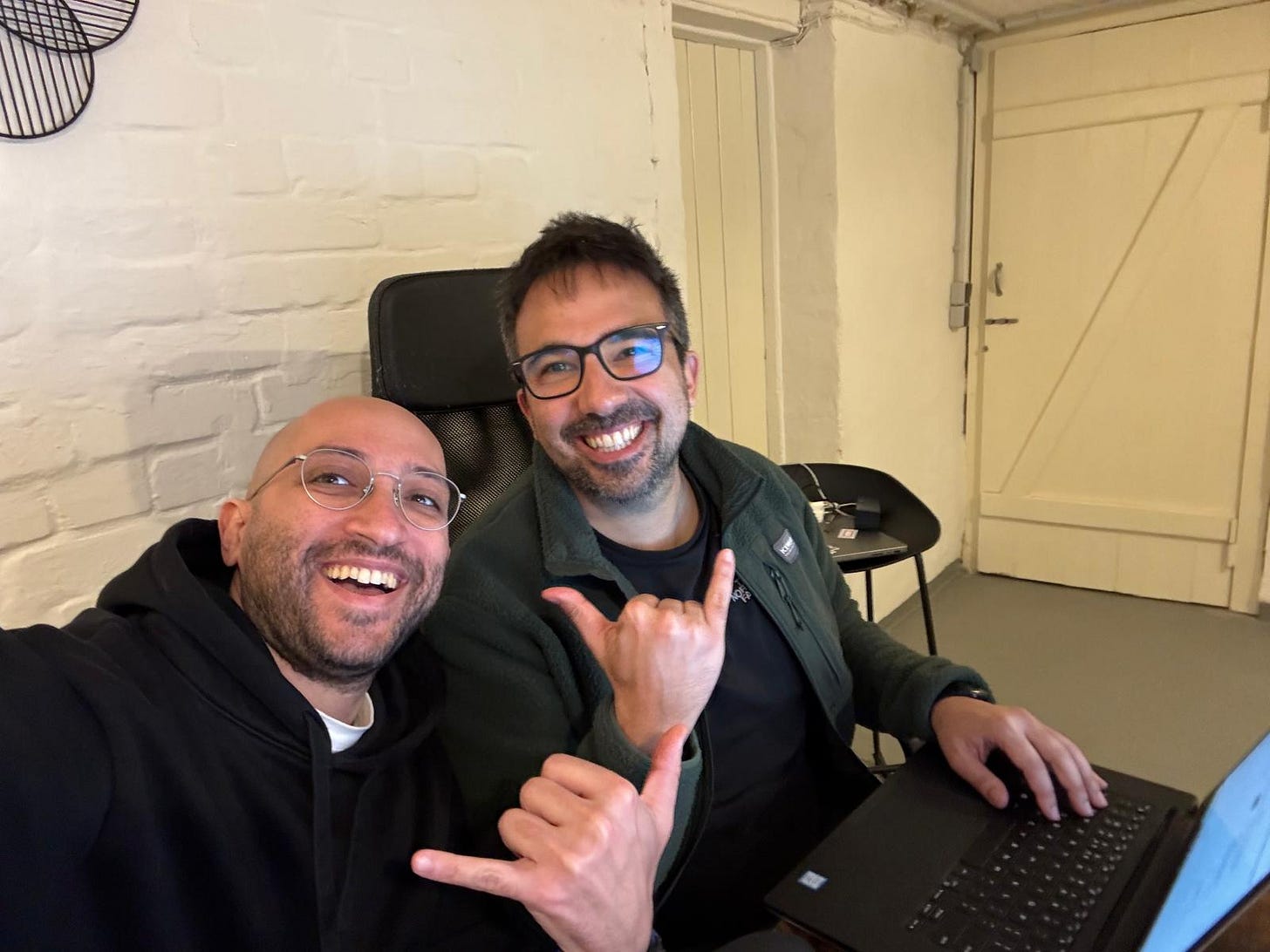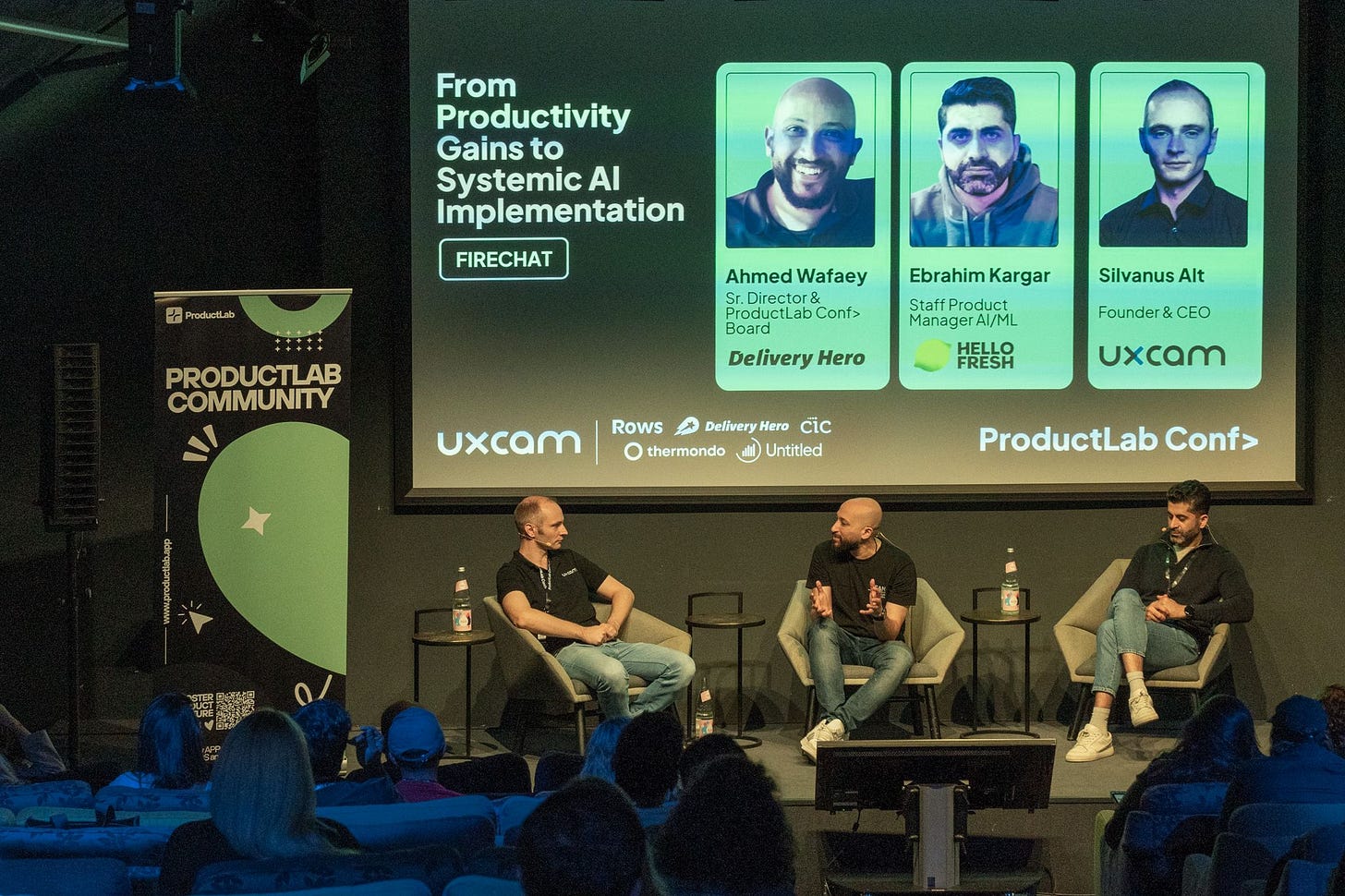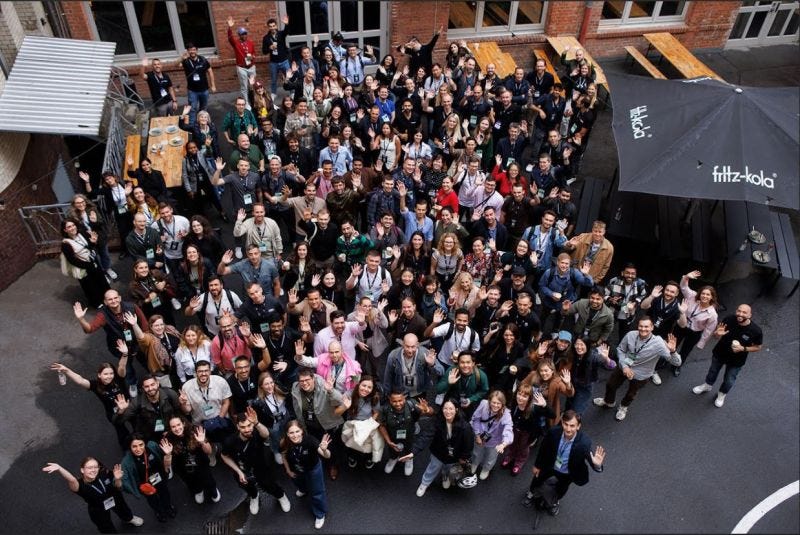Learn, Earn, Return: What a Year of Product Conference Building Taught Me About Product Leadership
“Why are you doing this?” they asked. I couldn’t answer in spreadsheets. But I learned more organizing one conference than in x years of building products.
Discover the playbook every Product Manager needs in 2025: how building real community —> beyond frameworks and job titles unlocks exponential growth in the age of AI.
In this article, you’ll learn how to avoid career stagnation, why horizontal growth matters, and concrete steps to expand your impact, build resilience, and accelerate your product career through the Learn–Earn–Return cycle.
One year ago, this started as a conversation with Daniele Ronca (the founder of Product lab) if we can host Marty Cagan in Berlin. Just a conversation.
A what-if. The market was rough. Jobs were drying up. Nobody was betting big on anything. And guess what: the event happened.
What we’ve noticed on that night was: this hunger.
You could feel it in every coffee chat during the event, every LinkedIn DM directly after, and so, we decided to do something about it and accordingly I’ve joined product lab as a board member for 2025 conference in Berlin.
I didn’t realize that decision would mean a year of my life. A year of explaining the vision to speakers who’d never heard of us. A year of budget spreadsheets that made our stomach turn. A year of plans changing, people canceling, doubts creeping in at 3 AM when we couldn’t sleep.
Everyone kept asking: “What’s the ROI? What’s the business model? Why are you pouring your life into this?” 👀
They were measuring the wrong thing.
And nobody tells you: the fastest way to grow as a product leader isn’t climbing the ladder. It’s building the campfire.
The Problem Most PMs Don’t See
We spend our careers learning frameworks. We read books, attend webinars, collect certifications. We climb from APM to PM to Senior PM to Principal. We earn the title, the salary, the respect.
But somewhere in that climb, we stop learning. We start repeating. We become isolated in our companies, in our processes, in our way of thinking.
And when the market shifts, when AI rewrites the rules, when the job disappears, we realize: we’ve been optimising for the wrong thing.
Remember: Career ladder is vertical. Real growth is horizontal.
What Started in a Basement (Learn)
The preparations of ProductLab Conference started small and from a continuous chat in a basement.
A handful of 2 ambitious people in Berlin who wanted to learn, exchange ideas, grow together. No one was getting paid, just a founder of established community and a board member.
That’s where you find the signal. Not in the business plan, but in the people who show up when there’s nothing to gain but connection and knowledge.
That was the first lesson:
Community is where you learn what your company can’t teach you.
Inside your company, you learn one way of doing things. One tech stack. One customer segment. You become fluent in your company’s dialect of product management.
But in a community/external network? You meet the PM from Amsterdam who approaches growth completely differently. The Berlin PM who thinks in systems. The Munich PM solving the exact problem you’re stuck on, but from a totally different angle.
The Year Nobody Sees (Earn)
I spent years earning credibility in product management. Evolving teams. Creating Capabilities. Shipping products. Proving I could deliver. That’s what we’re trained to do: create value inside our organizations.
But organizing this conference? That was earning something different. Earning trust from a community I didn’t own. Earning respect from speakers who didn’t know us. Earning the right to ask 250+ people to spend 2 days with us.
What a year of organizing a conference actually looks like:
Month 1-3: Pure momentum. Everything feels possible. You’re signing speakers, sketching out the dream. I’m learning to sell a vision with zero proof.
Every conversation with a potential speaker is a pitch where we have no metrics, no track record, just conviction.
Lesson: Before you have data, you need belief. Before you have traction, you need trust. we’re earning credibility one conversation at a time.
Month 4-6: Reality hits. The venue costs more than you thought. Two keynote speakers drop out. The market gets worse. Your partner asks, “Are we sure about this?”
Lesson: Every product faces this moment. The gap between vision and reality. Most PMs panic and start cutting scope randomly. I learned to ask better questions: What’s the core experience? What can’t we compromise on? This is stakes-setting, just like defining your product’s wedge.
Month 7-9: The grind. Content curation. A thousand small decisions. Negotiating with everyone who want to sell, not support. Reviewing proposals. Rewriting the schedule. Again. And again. Tiredness becomes your baseline.
Lesson: I’m doing product management, just not on software. I’m curating an experience. I’m making trade-offs. We’re saying no to good ideas to protect the great ones. Every framework I use at work applies here, and suddenly I see them differently.
Month 10-12: Panic and faith in equal measure. Last-minute changes. Doubts everywhere. But also: momentum. Ticket sales. People messaging you saying, “I can’t wait.” You remember why you started.
Lesson: The echo starts before you ship. People were excited about the conference before it happened. That’s signal. In product work, we wait for launch to measure success. We should be listening for the echo much earlier.
Throughout it all, the question kept coming: “What are you getting out of this?”
I was earning a different kind of credential. Not a title. Not a salary bump. I was earning the pattern recognition that only comes from building something from zero in public.
The Day It All Made Sense (Return)
Then the conference happened. 250+ people. From painting a vision of PMs as architects of the future. To many panel moderations about AI era. And a lab day with many workshops, that were really engaging.

And I understood something profound about product management.
The real product wasn’t the talks. It was the spaces between them.
You could feel it. A PM from Rome explaining her challenges to someone from Munich. Three people surrounding facilitators during lunch, asking about data frameworks. Conversations about AI panel continuing into the after-lunch.
This is what we miss in product management: we obsess over the features, the shipped code, the demo. But the value often emerges in the spaces we don’t control.
The way users combine our tools with others. The conversations our product enables. The community that forms around solving similar problems.
People weren’t just learning. They were connecting. Finding their people. Realizing they weren’t alone in their struggles. This is the return: not what I got back, but what I got to give back.
Isn’t this exactly what great product leadership looks like? You set the conditions for valuable interactions, then get out of the way.
And the real proof came in the messages after:
“How did you do that?”
“When’s the next one?”
“This is what Berlin needed.”
Remember: Return isn’t the end of the cycle. It’s the accelerant.
The more I gave back to the community, the more I learned. The more I learned, the more I could earn. Not in a transactional way, but in a compounding way.
Why Learn, Earn, Return Matters for Product Managers
Most PM career advice is linear: Get good at the craft. Build products. Get promoted. Repeat.
That’s the trap. You optimize for the ladder, and you stop growing horizontally. You become really good at one company’s way of doing things, but fragile to market shifts.
The PMs who are thriving right now aren’t the ones with the best titles. They’re the ones with the strongest communities.
Learn: Your company teaches you one playbook. Community teaches you twenty. When AI disrupted product management overnight, the PMs who were active in communities already knew how others were adapting. They’d seen the signals. They weren’t starting from zero.
Earn: Your work inside a company earns you a title and a salary. Your work in community earns you trust and recognition from people who don’t have to care about you. That’s a different kind of credential, and it’s more portable.
Return: This is the part most PMs skip. They learn, they earn, they... keep climbing. But when you return value to the community, something magical happens. You learn faster because you’re teaching. You earn deeper relationships because you’re giving first. You become magnetic to opportunities because people remember who showed up when there was nothing to gain.
Remember: When you build something for no reason other than it mattering, you learn what matters.
The Real ROI: Compounding Returns
What started as a conversation in Q4 2024 became Berlin’s first product conference. What began in a basement became a full venue with 250+ product people
And now? Product lab already planning 2026. More workshop tracks. Deeper frameworks. International speakers. I wish them all the best to keep growing 💪.
Takeaways for you
1. The magic is in the margins.
We obsess over keynotes, but people remembered the hallway conversations. In product: we obsess over features, but users remember how something made them feel. Design for the margins, not just the main path.
2. Community compounds, products depreciate.
Every feature you ship starts aging immediately. Every connection you help create starts compounding. What if you built your product to facilitate connections between users, not just between user and product?
3. You can’t engineer serendipity, but you can create conditions for it.
The best moments at the conference weren’t scripted. But they happened because we created the right conditions: diverse attendees, generous time buffers, permissionless conversation spaces. Same with products: create conditions for users to surprise you.
4. The echo tells you everything.
People were excited before the conference happened. That was the real signal. We spend too much time building in silence, then measuring post-launch. Listen for the echo while you’re building. If people aren’t excited before you ship, shipping won’t fix it.
Before we close, let’s practice what we preach @ Product Voyagers
I’d be a hypocrite if I wrote about Learn-Earn-Return without showing you how We’re living it.
Product Voyagers, this Substack you’re reading, is our ( Anela Sencar Hoti & me) other campfire. It’s a content-led community where we share the frameworks, mental models, and hard-won lessons from building products in the AI era.
And we didn’t start Product Voyagers to build an audience. We started it because of having the same conversations over coffee. PMs asking: “How do I think about products? How do I tell better product stories? How do I lead when everything is changing?”
We were learning these answers by doing the work. So we started returning what we learned through writing.
The Learn part: Every article starts with a problem we’re wrestling with or a pattern I’m seeing across multiple PMs. We’re not writing from expertise; we’re writing from exploration.
The Earn part: The credibility doesn’t come from having all the answers. It comes from being willing to think out loud, to challenge conventional wisdom, to say “the MVP framework is broken” when everyone else is repeating it.
The Return part: This article you’re reading? This is me giving back what I learned from organizing ProductLab. The frameworks I develop here (like the Entry Stakes, Wedge, Obsession Loop model) are tools I wish I had when I was earlier in my career.
And the compound effect is real: the more I write, the more I learn from the community that forms around it. The more I learn, the better the content gets. The better the content, the more valuable the community becomes.
That’s the Learn-Earn-Return cycle in action!
And if you want to join the Product Voyagers community, you’re already here. Subscribe to get frameworks and mental models for building products that matter.





